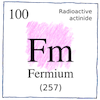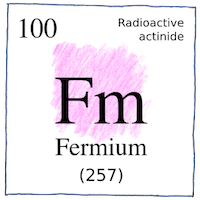Berkeley, Argonne, Los Alamos—Albert Ghiorso
and co-workers at Berkeley, Argonne, and Los Alamos
elements

|
Fermium
After identifying elemement 99, Albert Ghiorso and his co-workers turned their attention to the cause of an even higher-energy alpha emission from materials from the fallout of Ivy Mike on Enewetak Atoll. The teams at the Berkeley and Argonne labs performed ion-exchange elution separations to show that the element with atomic number 100 had been created.
Atomic number 100
Einsteinium and fermium are intensely radioactive and toxic although we are not likely to encounter them in everyday life. They are produced in laboratories and by nuclear reactors and explosions, and they decay within a few months into lighter but equally harmful elements: californium berkelium curium americium plutonium neptunium The tests at Enewetak and Bikini required the evacuation of the people who had lived there. The radioactive fallout from the tests still render the islands of the atolls unsafe for habitation.
Secrecy
The detonation on Enewetak Atoll on 1 November 1952 was the first successful test of a hydrogen bomb. Discovery of einsteinium and fermium was kept secret because of cold-war tensions until 1955. Knowledge is power, so secrecy, like power, corrupts.



The Soviets efforts to build a hydrogen bomb began with the design by Andrei Sakharov and Vitaly Ginzburg in 1949. Sahkarov later became a dissident and activist for disarmament, peace, and human rights.
Enrico Fermi wrote the following about the hydrogen bomb on 6 May 1954:
Albert Einstein wrote on 22 January 1947:
See also in The book of science:
Readings in wikipedia:
Other readings: